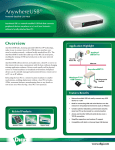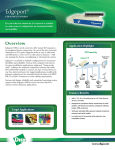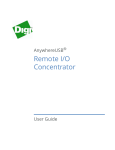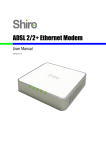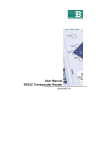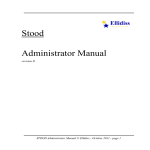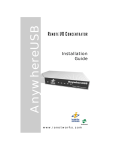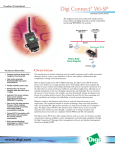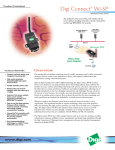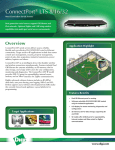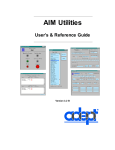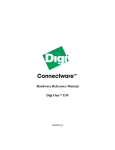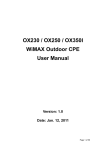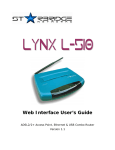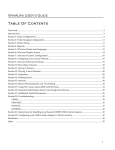Download AnywhereUSB Remote I/O Concentrator
Transcript
AnywhereUSB TS® Remote I/O Concentrator User Manual www.digi.com © 2010 Digi, Digi International, the Digi logo, RealPort, USB Over IP, AnywhereUSB, Watchport, Edgeport, and Hubport are either trademarks or registered trademarks of Digi International, Inc. in the United States and/or other countries. Microsoft, Windows, Windows NT, Windows Server, Windows Vista are trademarks of Microsoft Corporation. All other trademarks are the property of their respective holders. Information in this documentation is subject to change without notice and does not represent a commitment on the part of Digi International. Digi International provides this document “as is,” without warranty of any kind, either expressed or implied, including, but not limited to, the particular purpose. Digi International may make improvements and/or changes to this documentation or to the product(s) and/or program(s) described in this documentation at any time. Digi International assumes no responsibility of any errors, technical inaccuracies, or typographical errors that may appear in this documentation, nor liability for any damages arising out of its use. Changes are made periodically to the information herein; these changes may be incorporated in new editions of the publication. For U.S. Government use: Any provision of this document and associated computer programs to the U.S. Government is with “Restricted Rights.” Use, duplication, or disclosure by the government is subject to the restrictions set forth in, subparagraph (c) (1) (ii) of the Rights in Technical Data and Computer Software clause of DFARS 52.277- 7013. For non-U.S. Government use: These programs are supplied under a license. They may be used, disclosed, and/or copied only as supplied under such license agreement. Any copy must contain the above copyright notice and restricted rights notice. Use, copying, and/or disclosure of the programs is strictly prohibited unless otherwise provided for in the license agreement. AnywhereUSB TS44 User Manual (90001086_C) 3 Digi Contact Information Product information is available on the Digi website, www.digi.com, including: Support Forums Knowledge Base Data sheets/product briefs Application/solution guides Regulatory Information For more information about Digi products, or for customer service and technical support, contact Digi International. To Contact Digi International by: Use: Mail Digi International 11001 Bren Road East Minnetonka, MN 55343 U.S.A. World Wide Web: http://www.digi.com/support/ Email http://www.digi.com/support/ Telephone (U.S.) (952) 912-3444 or (877) 912-3444 Telephone (other locations) +1 (952) 912-3444 or (877) 912-3444 AnywhereUSB TS44 User Manual (90001086_C) 3 This Page is Left Intentionally Blank AnywhereUSB TS44 User Manual (90001086_C) 4 Contents 1 2 3 4 5 6 7 8 Introduction 7 Product Overview AnywhereUSB TS Interpreting the Status LEDs Features User Interfaces IP Address Assignment RealPort Software Security Features Configuration Management 7 8 9 10 10 10 11 12 12 Getting Started 13 In the Box Cabling 13 13 Installing the Software 14 Installing the Drivers Uninstalling the Drivers 14 17 Initial AnywhereUSB Configuration 18 Initial Configuration 18 Configuring the PC to Connect to an AnywhereUSB 20 Connecting to the AnywhereUSB 20 Using the Configuration Utility Program 22 Configuration Utility Main Window Menu Options 22 23 Discovering AnywhereUSB Devices on Other Subnets 29 Adding IP addresses to the Discovery List Manager 29 Using the Web User Interface 30 Home Page 30 AnywhereUSB TS44 User Manual (90001086_C) 5 9 10 11 Configuration Management Administration 31 49 49 Configuring via the Command Line 59 Accessing the Command Line 59 Hardware Specifications 61 Dimensions Environmental Power Requirements Hardware Interface Features Serial Interface Network Interface Features 61 61 61 62 62 62 Regulatory and Safety Information 63 Appendix A AnywhereUSB Permitted Device List Appendix B Understanding Hubs Appendix C Configuring for Firewall Support AnywhereUSB TS44 User Manual (90001086_C) 64 64 66 66 67 67 6 1 Introduction This chapter provides a brief overview of the AnywhereUSB TS® Remote I/O Concentrator. Product Overview The AnywhereUSB TS® Remote I/O Concentrator is the first remote networking solution to utilize both RealPort® (serial over IP) and RealportUSB® (USB over IP®) technology. USB and serial devices may be located anywhere on a wired or wireless LAN – without a locally attached host PC. Since the host PC or server may be located remotely, AnywhereUSB TS enables devices to be deployed in harsh or non-secure environments, making it ideal for point-of-sale, kiosks, surveillance, industrial automation, or any mission-critical enterprise application. The AnywhereUSB TS/44 model provides four USB ports and four serial ports to connect peripheral devices such as bar-code scanners and receipt printers, as well as Digi’s Watchport®/V2 USB Camera and Watchport Sensors. The unit provides a built in Web Server and a command line (via Telnet) for additional configuration options. AnywhereUSB TS44 User Manual (90001086_C) 7 AnywhereUSB TS Front Panel Back Panel AnywhereUSB TS44 User Manual (90001086_C) 8 Front Panel for the AnywhereUSB TS System Status LED: Blinks green during normal operation. USB LEDs: Solid green when USB port is controlled by host PC; off when port is unowned. Reset Button: Used to either reboot the device or reset its configuration to factory defaults. Interpreting the Status LEDs The AnywhereUSB TS has five LEDs on the front panel: one System Status LED and four USB Port LEDs. When powered on the System Status LED blinks green. When the USB ports are owned by a host PC, the USB LEDs will be solid green; if the USB port is unowned, the USB Port LED will remain off. AnywhereUSB TS44 User Manual (90001086_C) 9 Features Following is an overview of configurable features of the AnywhereUSB TS/44. User Interfaces There are several user interfaces for configuring and monitoring the AnywhereUSB family, including: The Digi Device Setup Wizard, a wizard-based tool for assigning an IP address. Web-based interface for configuring, monitoring, and administering. Telnet Command-Line Interface. Simple Network Management Protocol (SNMP) AnywhereUSB Configuration Utility IP Address Assignment There are several ways to assign an IP address to an AnywhereUSB: Static IP: Assign a specific IP address to a device, through the Digi Device Setup Wizard, the Web user interface, or the Command-Line Interface. Using Dynamic Host Configuration Protocol (DHCP). The AnywhereUSB device’s default configuration is as a DHCP client. Dynamic Host Configuration Protocol (DHCP) is an Internet protocol for automating the configuration of computers that use TCP/IP. DHCP can be used to automatically assign IP addresses, to deliver TCP/IP stack configuration parameters such as the subnet mask and default router, and to provide other configuration information. Auto Private IP Addressing (APIPA), also known as Auto-IP: A standard protocol that will automatically assign an IP address from a reserved pool of standard Auto-IP addresses to the computer on which it is installed. The device is set to obtain its IP address automatically from a DHCP server. But if the DHCP server is unavailable or nonexistent, Auto-IP will assign the device an IP. If DHCP is enabled or responds later or you use ADDP, both will override the Auto-IP address previously assigned. AnywhereUSB TS44 User Manual (90001086_C) 10 RealPort Software The AnywhereUSB TS uses the patented RealPort COM/TTY port redirection for Microsoft Windows environments. RealPort software provides a virtual connection to serial devices, no matter where they reside on the network. The software is installed directly on the host PC and allows applications to talk to devices across a network as though the devices were directly attached to the host. Actually, the devices are connected to a Digi device somewhere on the network. RealPort is unique among COM port re-directors because it is the only implementation that allows multiple connections to multiple ports over a single TCP/IP connection. Other implementations require a separate TCP/IP connection for each serial port. Unique features also include full hardware and software flow control, as well as tunable latency and throughput. Encrypted RealPort AnywhereUSB TS supports the patent-pending RealPort software with encryption. Encrypted RealPort offers a secure Ethernet connection between the COM or TTY port and a device server or terminal server. Encryption prevents internal and external snooping of data across the network by encapsulating the TCP/IP packets in a Secure Sockets Layer (SSL) connection and encrypting the data using Advanced Encryption Standard (AES), one of the latest, most efficient security algorithms. Digi’s RealPort with encryption driver has earned Microsoft’s Windows Hardware Quality Lab (WHQL) certification. Drivers are available for a wide range of operating systems. It is ideal for financial, retail/point-of-sale, government or any application requiring enhanced security to protect sensitive information. Access to Encrypted RealPort services can be enabled or disabled. AnywhereUSB TS44 User Manual (90001086_C) 11 Security Features Security-related features in AnywhereUSB include: Secure access and authentication - One password, one permission level. - Can selectively enable and disable network services such as ADDP, HTTP/HTTPS, Remote Login, Remote Shell, SNMP, and Telnet. - Can control access to inbound ports. - Secure sites for configuration: HTML pages for configuration have appropriate security. Encryption: - Encrypted RealPort offers encryption for the Ethernet connection between the COM/TTY port and the AnywhereUSB TS. SNMP Security: - Authorization: Changing public and private community names is recommended to prevent unauthorized access to the device. - You can disable SNMP set commands to make use of SNMP read-only. Configuration Management Once an AnywhereUSB is configured and running, configurationmanagement tasks need to be periodically performed, such as: Upgrade Firmware Copying configurations to and from a host PC Software and Factory Resets Rebooting the device File management AnywhereUSB TS44 User Manual (90001086_C) 12 2 Getting Started This chapter explains what comes with the AnywhereUSB and how to connect it to a Network. In the Box AnywhereUSB TS/44 Digi AnywhereUSB Installation CD Power Supply Cabling To connect your AnywhereUSB to a Network: 1. Connect a standard Ethernet Network to your AnywhereUSB. 2. Connect the other end of the Ethernet cable to a 10-/100-BaseT switch or hub. 3. Connect one end of the power supply into the back of the AnywhereUSB and the other end into an AC outlet. AnywhereUSB TS44 User Manual (90001086_C) 13 3 Installing the Software This chapter discusses installing the AnywhereUSB drivers, RealPort drivers, and uninstalling the drivers. Installing the Drivers AnywhereUSB Drivers Installing the AnywhereUSB drivers requires the use of an account that has administrative privileges. For Windows XP, Vista, Server 2003, Server 2008, and Windows 7 1. Insert the Digi AnywhereUSB CD into the CD drive. 2. Select Install Drivers from the Digi splash screen. If the Digi splash screen does not launch, run the AWSplash.exe program from the CD. AnywhereUSB TS44 User Manual (90001086_C) 14 3. A DOS Box will come up indicating the Install Process was successful. 4. Press the enter key to exit the DOS Box. The unit is now ready for configuration (see section 4). RealPort Drivers Installing the RealPort drivers requires the use of an account that has administrative privileges. 1. Select Install RealPort from the Digi splash screen. 2. Select Next when the Digi RealPort Setup Wizard Welcome screen pops up. 3. Select the IP address to connect to the AnywhereUSB TS44. 4. Configure as needed. AnywhereUSB TS44 User Manual (90001086_C) 15 AnywhereUSB TS44 User Manual (90001086_C) 16 Uninstalling the Drivers To uninstall the AnywhereUSB drivers: 1. Launch the AnywhereUSB Configuration Utility from the Start menu. 2. Select Preferences from the File menu and then click the Uninstall button. 3. Reboot the PC to complete the driver removal. To uninstall the RealPort drivers: 1. Go into the Device Manager. 2. Under Multi-port serial adapters, select the AnywhereUSB TS44. 3. Select Uninstall. AnywhereUSB TS44 User Manual (90001086_C) 17 4 Initial AnywhereUSB Configuration This chapter explains how to configure the IP address in a new AnywhereUSB unit. Initial Configuration To begin the initial configuration: 1. Launch the AnywhereUSB Configuration Utility from the Start menu. A new AnywhereUSB will attempt to obtain an IP address from a DHCP Server. If one is not available, it will self-generate an AutoIP address. 2. Right click the AnywhereUSB entry and click the Configure button, or double click to configure the AnywhereUSB unit. 3. Enter a Device Name that easily identifies the AnywhereUSB. AnywhereUSB TS44 User Manual (90001086_C) 18 To Configure DHCP: 1. Select the Enable button 2. When DHCP is enabled, the AnywhereUSB will wait for a DHCP Server. If a DHCP response is not received, the AnywhereUSB will revert to an AutoIP address. To Configure a static IP address: 1. Select the Disable button. 2. Enter and IP address manually. AnywhereUSB TS44 User Manual (90001086_C) 19 5 Configuring the PC to Connect to an AnywhereUSB This chapter explains how to configure the PC to establish a connection to the AnywhereUSB unit. Connecting to the AnywhereUSB In order to use the USB devices that are attached to the AnywhereUSB, the PC must establish a connection to the AnywhereUSB by adding the units IP address to the Connection List. 1. Launch the AnywhereUSB Configuration Utility from the start menu. The utility displays a list of all AnywhereUSB devices on your local subnet and on any subnet configured in the Discovery List. AnywhereUSB TS44 User Manual (90001086_C) 20 2. Select an AnywhereUSB from the AnywhereUSB Configuration Utility Main Window and then either click the Connect button or right click on the selected AnywhereUSB and click Connect from the drop down box. The host computer then attempts to connect to the AnywhereUSB. AnywhereUSB TS44 User Manual (90001086_C) 21 6 Using the Configuration Utility Program This chapter explains how to use the AnywhereUSB Configuration Utility. Configuration Utility Main Window The AnywhereUSB Configuration Utility displays AnywhereUSB devices grouped by their subnet addresses. The Utility automatically discovers AnywhereUSB devices on the local subnet; to discover devices on other subnets, add those subnet addresses to the Discovery List (see Section 7 Discovering AnywhereUSB Devices on Other Subnets). AnywhereUSB TS44 User Manual (90001086_C) 22 Icon Color Legend: Green—Available For Connection Gray, Bold Text—Connected to this computer. Gray—In use by other host PC. Red—Firmware is being updated. AnywhereUSB IP Address has not yet been configured Note: After the AnywhereUSB Configuration Utility has been launched it will reside in the system tray. To open the utility, double click the AnywhereUSB icon in the system tray. Menu Options File Menu: Preferences The AnywhereUSB Concentrator Detection option allows for the configuration of how often and if the Configuration Utility queries the network for AnywhereUSB units. The Detection Timeout configures how long the Configuration Utility will wait to hear from all the AnywhereUSB devices before the Configuration Utility updates the list of units in the Main Window. AnywhereUSB TS44 User Manual (90001086_C) 23 The Use Microsoft Device IDs option changes how the AnywhereUSB software creates the Device ID for attached USB devices. A Device ID consists of 3 parts: the name of the bus driver, the Product Identifier, and a unique serial number. For example, a Digi Edgeport USB to Serial converter that is plugged directly into the USB port of a PC would have a Device ID similar to: USB\VID_1608&PID_0215\A20299384 (Where “USB” indicates the Microsoft USB bus driver) In the case of attaching devices to an AnywhereUSB unit, the bus driver name is “AWUSB”, so the same device plugged into an AnywhereUSB unit would have the following Device ID: AWUSB\VID_1608&PID_0215\A20299384. Some USB class drivers expect to see the bus driver name as “USB”, and as a result will not operate unless the “Use Microsoft Device IDs” checkbox is checked. AnywhereUSB TS44 User Manual (90001086_C) 24 Edit Menu: Connection List Displays the IP addresses of the AnywhereUSB to which the PC will try to connect. When an IP Address is added to this list, the Host PC immediately tries to connect to the AnywhereUSB. If an IP Address is deleted from the Connection List, the AnywhereUSB unit will disconnect from the host PC and return to a “Available for Host Connection” state. AnywhereUSB TS44 User Manual (90001086_C) 25 Edit Menu: Discovery List Displays a list of subnet addresses of remote networks or IP Addresses of individual units where the configuration utility will search for AnywhereUSB units. AnywhereUSB TS44 User Manual (90001086_C) 26 Command Menu: Configure This dialog configures the Device Name and IP address properties of the AnywhereUSB unit. Checking the Add to connection list box adds the IP address to the connection list. The Remote Hub field allows for a unique name to be given to the AnywhereUSB. AnywhereUSB TS44 User Manual (90001086_C) 27 Command Menu: Connect This command allows the IP Address of the AnywhereUSB to be added to the connection list once the AnywhereUSB is selected in the Main Window. Command Menu: Reboot This command causes the AnywhereUSB to reboot. View Menu: Driver Information This command displays the version numbers of the AnywhereUSB drivers and firmware and allows for the uninstalling of the drivers. View Menu: Refresh (F5) This command updates the discovered AnywhereUSB listed in the Main Window. AnywhereUSB TS44 User Manual (90001086_C) 28 7 Discovering AnywhereUSB Devices on Other Subnets This chapter explains how to enable the Configuration Utility to discover AnywhereUSB units on additional IP subnets. Adding IP addresses to the Discovery List Manager To discover AnywhereUSB devices on other subnets, add their addresses to the Discovery List in the Discovery List Manager dialog box. 1. Select Discovery List from the Edit menu. 2. Add the Subnet addresses or the IP Address of the individual device to the Discovery List Manager. For example, to add the Class C network 192.168.2.x, enter 192.168.2.255. For a Class B network example of 145.75.x.x, enter 145.75.255.255 (the router must be configured to forward subnet broadcasts). 3. Enter the desired IP address, and then click the Add button. AnywhereUSB TS44 User Manual (90001086_C) 29 8 Using the Web User Interface This chapter describes using the Web user interface’s Configuration, Management, and Administration sections and their corresponding submenus Home Page The Home page is displayed when the Web user interface is opened. The Home Page The left side of the Home page has a list of choices that display pages for Configuration, Management, and Administration tasks, and to logout of the Web interface. AnywhereUSB TS44 User Manual (90001086_C) 30 Clicking Logout logs out of a configuration and management session with an AnywhereUSB. It does not close the browser window, but displays a logout window. To finish logging out of the Web interface and prevent access by other users, close the browser window. Or, log back on to the device by clicking the link on the screen. After 5 minutes of inactivity, the idle timeout also automatically performs a user logout. Applying and Saving Changes The Web interface runs locally on the device, which means that the interface always maintains and displays the latest settings in the AnywhereUSB. Cancelling Changes To cancel changes to configuration settings, click the Refresh or Reload button on the Web browser. This causes the browser to reload the page. Any changes made since the last time the Apply button was clicked are reset to their original values. Restoring the AnywhereUSB to Factory Defaults The device configuration can be reset to factory defaults as needed during the configuration process. Online Help Online help is available for all screens of the Web interface, and for common configuration and administration tasks. There is also tutorial available on the Home page. The Getting Started section has a link to a tutorial on configuring and managing the AnywhereUSB. The System Summary section notes all available device-description information. Configuration The configuration section of the Web user interface consists of five submenus: Network, Serial Ports, System, Remote Management, and Security. View and Change IP Settings, as needed The IP Settings page shows how the IP address for the AnywhereUSB is obtained, whether by DHCP or by static IP address, subnet mask, default gateway. Contact your network administrator for more information about these settings, and see the online help. AnywhereUSB TS44 User Manual (90001086_C) 31 Enabling and Disabling Network Services The Network Services page shows a set of common network services that are available for the AnywhereUSB, and the network port on which the service is running. Common network services can be enabled and disabled and the TCP port on which the network service listens can be configured. Disabling services may be done for security purposes. That is, certain services can be disabled so the device runs only those services specifically needed. To improve device security, non-secure services such as Telnet can be disabled. It is usually best to use the default network port numbers for these services because they are well known by most applications. Several services have a setting for whether TCP keep-alives will be sent for the network services. TCP keep-alives can be configured in more detail on the Advanced Network Settings page AnywhereUSB TS44 User Manual (90001086_C) 32 Advanced Network Settings The Advanced Network Settings are used to further define the network interface, including: Host Name is placed in the DHCP Option 12 field. This is an optional setting which is only used when DHCP is enabled. Static Primary/Secondary DNS are the IP addresses of Domain Name Servers (DNS) used to resolve computer host names to IP addresses. Static DNS servers are specified independently of any network interface and its connection state. An IP address of 0.0.0.0 indicates no server is specified. DNS Priority is a List of DNS servers in priority order used to resolve computer host names. Each type of server is tried, starting with the first in the list. For each server type, the primary server is tried first. If no response is received, then the secondary server is tried. If neither server can be contacted, the next server type in the list is tried. A network interface may obtain a DNS server from DHCP or other means when it is connected. If an interface does not obtain a DNS server, it will be skipped and the next server in the priority list will be tried. To change the priority order, select an item from the list and press the up or down arrow. AnywhereUSB TS44 User Manual (90001086_C) 33 Ethernet Interface permits the configuration of Ethernet speed and duplex settings. TCP Keep Alive Settings include an Idle Timeout which specifies the period of time that a TCP connection has to be idle before a keepalive is sent, a Probe Interval in seconds between each keep-alive probe, and a Probe count which is the number of times TCP probes the connection to determine if it is alive after the keep-alive options has been activated. The connection is assumed to be lost after sending this number of keep-alive probes. Serial Port Configuration Use the Serial Port Configuration page to establish a port profile for the serial port of the AnywhereUSB TS. The Serial Port Configuration page includes the currently selected port profile for the serial port, detailed configuration settings for the serial port, dependent on the port profile selected, and links to Basic Serial Settings and Advanced Serial Settings. About port profiles Port profiles simplify serial port configuration by displaying only those items that are relevant to the currently selected profile. There are several AnywhereUSB TS44 User Manual (90001086_C) 34 port profile choices, but not all port profiles are supported in all products. Support of port profiles varies by product. If a profile listed in this description is not available on the page, it is not supported. If a port profile has already been selected, it is shown at the top of the screen. The profile can be changed, or retained but individual settings adjusted. Everything displayed on the Serial Port Configuration screen between Port Profile Settings and the links to the Basic Serial Settings and Advanced Serial Settings depends on the port profile selected. When using serial ports for the terminal emulator’s host or keyboard connections, those ports must be configured for the Custom port profile. Select and configure a port profile 1. 2. 3. 4. 5. To configure any profile select Serial Ports. Click the port to be configured. Click Change Profile. Select the appropriate profile and Click Apply. Enter the appropriate parameters for each profile; descriptions of each profile follow. 6. Click Apply to save the settings. A list of the ports available on the Digi device server along with a summary of each port's current configuration is displayed when you select Serial Ports under the Configuration heading. AnywhereUSB TS44 User Manual (90001086_C) 35 To edit the settings of a port: Click on that port's link under the Port heading. Port Profile A port profile allows you to easily configure a serial port based on how you will be using that port. By selecting one of the pre-defined profiles, the configuration options are focused only on the settings required for that particular profile. For situations that don't fit into one of the pre-defined port profiles, select the Custom profile option. All of the port options are available in the custom profile. Basic Serial Settings Description The Description specifies an optional character string that can be used to identify the device connected to the port Baud Rate Data Bits Parity AnywhereUSB TS44 User Manual (90001086_C) 36 Stop Bits Flow Control The basic serial port settings must match the serial settings of the connected device. If you do not know these settings consult the documentation that came with your serial device. These serial settings may be documented as 9600 8N1, which means that the device is using a baud rate of 9600 bits per second, 8 data bits, no parity, and 1 stop bit. When using RealPort (COM port redirection) or RFC 2217 these settings are supplied by applications running on the PC or server, and the default values on your Digi device server do not need to be changed. Advanced Serial Settings The advanced settings rarely need to be changed. TCP Settings These TCP Settings are available only when the current port is configured with the TCP Sockets or the Custom Profile. Send data only under any of the following circumstances: AnywhereUSB TS44 User Manual (90001086_C) 37 Enable if you need to specify the conditions when the Digi device server will send the data read from the serial port to the TCP destination. Send when data is present on the serial line Sends the data to the network host when a specific string of characters is detected on the serial line. Enter the string of 1 to 4 characters in the Match String field. Non-printable characters can be entered as follows below. Check Strip match string before sending to strip the string from the data before it is sent to the destination. hexadecimal values tab line feed backslash \xhh \t \n \\ Send after the following number of idle milliseconds Send the data after the specified number of milliseconds has passed with no additional data received on the serial port. This can be 1 to 65,535 milliseconds. Send after the following number of bytes Send the data after the specified number of bytes has been received on the serial port. This can be 1 to 65,535 bytes. Close connection after the following number of idle seconds Enable to close an idle connection. Use the Timeout field to enter the number of seconds that the connection will be idle before it is closed. This can be 1 to 65000 seconds. Close connection when DCD goes low When selected, the connection will be closed when the DCD (Data Carrier Detected) signal goes low. Close connection when DSR goes low When selected, the connection will be closed when the DSR (Data Set Ready) signal goes low. AnywhereUSB TS44 User Manual (90001086_C) 38 AnywhereUSB TS44 User Manual (90001086_C) 39 Configure System Settings The System Configuration page configures System settings, including device description information, such as the device name, contact, and location, and whether SNMP is enabled or disabled and the SNMP traps that are enabled. Configure Device Description Information A Device Description is a system description of the AnywhereUSB name, contact, and location. This device description can be useful for identifying a specific AnywhereUSB when working with a large number of devices in multiple locations. The device ID assigned to this device that corresponds to the device ID used by the Connectware server. This option only applies when the Connectware server is being used to configure and manage the device. AnywhereUSB TS44 User Manual (90001086_C) 40 Configure SNMP Simple Network Management Protocol (SNMP) is a protocol that can be used to manage and monitor network devices. Digi devices can be configured to use SNMP features, or SNMP can be disabled entirely for security reasons. To configure SNMP settings, click the Simple Network Management Protocol link at the bottom of the System Configuration page. SNMP settings include: Enable Simple Network Management Protocol (SNMP): This checkbox enables or disables use of SNMP. The Public community and Private community fields specify passwords required to get or set SNMP-managed objects. Changing public and private community names from their defaults is recommended to prevent unauthorized access to the device. - Public community: The password required to get SNMPmanaged objects. The default is public. AnywhereUSB TS44 User Manual (90001086_C) 41 - Private community: The password required to set SNMPmanaged objects. The default is private. Allow SNMP clients to set device settings through SNMP: This checkbox enables or disables the capability for users to issue SNMP “set” commands uses use of SNMP read-only for the AnywhereUSB. Enable Simple Network Management Protocol (SNMP) traps: Enables or disables the generation of SNMP traps. At the bottom of the page are checkboxes for the SNMP traps that can be used: authentication failure, login, cold start, and link up traps. AnywhereUSB TS44 User Manual (90001086_C) 42 Configure Remote Management Remote Management Settings The Remote Management configuration page sets up the connection to the Connectware Manager server so the AnywhereUSB knows how to connect to the server. The Connectware Manager server allows devices to be configured and managed from remote locations. In order to properly use this facility, the Connectware Manager server must first be installed on a server system. For more information on installing the Connectware Manager server, consult the documentation that was included with the server. After installing the Connectware Manager server, the AnywhereUSB must be configured to properly communicate with the remote server system. First, you must configure the AnywhereUSB to have a proper Device ID. By default, the Device ID is created from the MAC address of the device. The Device ID can be configured on the System Configuration > Device Identity Settings page. AnywhereUSB TS44 User Manual (90001086_C) 43 Upon configuration of the Connectware Manager server and the Device ID, you must configure the following settings: Connection Settings These settings are used in connecting to the Connectware Manager server. You can choose how your AnywhereUSB connects to and communicates with the Connectware Manager server: through a clientinitiated or a server-initiated connection. In a client-initiated connection, the AnywhereUSB attempts to reach the Connectware Manager server to establish the connection. An advantage of the client-initiated connection is that it can be used on any network, whether the client device has a public or private IP address - as long as the Connectware Manager server is accessible on that network. A server-initiated connection works the opposite way. The Connectware Manager server opens a TCP connection and the AnywhereUSB listens for the connection. An advantage of a server-initiated connection is that the connection is only established when it is needed - this minimizes the overhead of maintaining a connection. A disadvantage is that Connectware Manager's device list will display the device as disconnected most of the time. In addition, server-initiated connections cannot be used if the device has a private IP address or is behind a NAT. Client-Initiated Management Connection: Enable Remote Management ... using a client-initiated connection When enabled, this client device will initiate the connection to the Connectware Manager server. This is the typical connection method. Server Hostname The IP address or hostname of the Connectware Manager server. Automatically reconnect to the server after being disconnected If enabled, the AnywhereUSB will wait the specified amount of time after a connection to the Connectware Manager server is ended, and then it will reconnect to the Connectware Manager server. Server-Initiated Management Connection: Enable Remote Management ... using a server-initiated connection When enabled, this device will listen for a connection which will be initiated by the Connectware Manager server. Enable Last Known Address (LKA) updates If enabled, the AnywhereUSB will make a connection to a Connectware Manager server for the purpose of informing the server of the current IP address of the AnywhereUSB. This permits the Connectware Manager to connect back to the device server, or to dynamically update a DNS with the IP address of the device. AnywhereUSB TS44 User Manual (90001086_C) 44 Retry if the LKA update fails If enabled, when a LKA update fails, the Digi device server will wait the specified amount of time before retrying the LKA update. Advanced Settings These settings are used in advanced situations and the defaults are typically suitable for most environments. These settings are used to control the keep alive settings of the various interfaces and should only be changed when the defaults do not properly work. Disconnect when Connectware Management is idle Idle Timeout Enables or disables the idle timeout for the connection. If enabled, an idle connection will be ended after the specified amount of time. Receive/Transmit Interval Wait Count Specifies the keep-alive interval to specify for packets received and packets transmitted. These settings are used in conjunction with the Wait Count to signal when the connection has been lost. Connection Method Specifies the method by which the associated interface connects to the remote server. The default TCP is typically good enough for most connections, and it is the most efficient method of connecting to the remote server in terms of speed and transmitted data bytes. The value Automatic is less efficient, but it is useful in situations where a firewall or proxy may prevent direct connection via TCP. Automatic will try each combination until a connection is made. Note that None has the same effect as selecting TCP. HTTP over Proxy Options Specifies the proxy settings required to communicate over a proxy network using HTTP. These settings only apply when Automatic or HTTP over Proxy is selected. AnywhereUSB TS44 User Manual (90001086_C) 45 AnywhereUSB TS44 User Manual (90001086_C) 46 Configure Security Features On the Security Page, you can specify the authentication information required for logging into the AnywhereUSB. By default there is no password authentication. If you are accessing the AnywhereUSB by opening the Web user interface or issuing a “telnet” command, no login prompt is displayed. If desired, you can enable password authentication. After changing the user name or password, you will immediately be asked to log back in to the Web interface using the new values. To further secure your AnywhereUSB, you might want to disable those network services not necessary to the device, or turn off any non-secure network services, such as Telnet. Network Services that Can Be Enabled or Disabled Network services that can be enabled or disabled include: ADDP: This service controls use of Advanced Digi Device Discovery Protocol. If it is disabled, you can no longer use the Digi Device Setup Wizard, or Digi Device Discovery utility to locate the device. RealPort or Encrypted RealPort: These services control use of COM port redirection. If disabled, COM port redirection cannot be used for the device. Remote Login (rlogin): Enables or disables the remote login (rlogin) service. If disabled, users cannot perform a remote login to the device. Remote Shell (rsh): Enables or disables the remote shell (rsh) service. Web Server or Secure Web Server (HTTP & HTTPS): These services control the use of the Web interface. If you disable them, device users cannot use the Web user interface or Java applet to configure, monitor, and administer the device. Telnet: Enables or disables the Telnet service. If disabled, users cannot Telnet to the device. SNMP: Enables or disables the use of SNMP. If disabled, SNMP services such as traps and device information are not used. Port Numbers for Network Services For each network service, the Port field shows the port on which the service is running. It is usually best to use the default TCP port numbers for these services because they are well known by most applications. AnywhereUSB TS44 User Manual (90001086_C) 47 AnywhereUSB TS44 User Manual (90001086_C) 48 Management The Management section displays additional information about the current connections to the AnywhereUSB. The example below lists four RealPort, one Telnet, and the RealPort USB connection between the PC and the AnywhereUSB TS44. Administration Administration tasks need to be performed on the AnywhereUSB such as file management, changing the password used for logging onto the device, backing up and restoring device configurations, updating firmware and Boot/POST code, restoring the device configuration to factory defaults, and rebooting the device. As with device configuration and monitoring, it covers performing administrative tasks through a variety of device interfaces. Administration from the Web Interface The Administration section of the Web interface main menu provides the following menus: File Management: For uploading and managing files, such as custom Web pages, applet files, and initializing files. AnywhereUSB TS44 User Manual (90001086_C) 49 Backup/Restore: For backing up or restoring a device’s configuration settings Update Firmware: For updating firmware, including Boot and POST code. Factory Default Settings: For restoring a device to factory default setting. System Information: For displaying general system information for the device and device statistics. Reboot: For rebooting the device File Management On the File Management page, you can upload files to the AnywhereUSB, such as custom HTML files if you are customizing the Web interface for AnywhereUSB. AnywhereUSB TS44 User Manual (90001086_C) 50 Backup/Restore Device Configurations Once the AnywhereUSB is configured, backing up the configuration settings is recommended in case problems occur later, firmware is upgraded, or hardware is added. If multiple devices need to be configured, the backup/restore feature can be used as a convenience, where the first device’s configuration settings are backed up to a file, and then the file is loaded onto the other devices. AnywhereUSB TS44 User Manual (90001086_C) 51 Update Firmware and Boot/POST Code The firmware and/or Boot/Post code for the AnywhereUSB can be updated from a file on a PC. The AnywhereUSB automatically determines the type of image being uploaded. Before uploading the firmware or the Boot/POST code, it is very important to read the Release Notes supplied with the firmware to check if the Boot/POST code must be updated before updating the firmware. Update Firmware from a File on a PC 1. From the main menu, click Administration > Update Firmware. The Update Firmware page is displayed. 2. Enter the name of the firmware or POST file in the Select Firmware edit box, or click Browse to locate and select the firmware or POST file 3. Click Update Important: DO NOT close the browser until the update is complete and a reboot prompt has been displayed. AnywhereUSB TS44 User Manual (90001086_C) 52 Restoring a Device Configuration to Factory Defaults Restoring the AnywhereUSB to its factory default settings clears all current configuration settings. In addition, any files that were loaded into the device through the File Management page are also removed. There are two ways to reset the device configuration of an AnywhereUSB to the factory default settings: from the Web interface and using the front panel reset button. The Restore Factory Defaults operation clears all current settings. If the “Keep network settings” check-box is checked, the network settings will not be reset. This is the best way to reset the configuration, because the settings can also be backed up using the Backup/Restore operation, which provides a means for restoring it after the configuration issues have been resolved. Using the Web Interface 1. Make a backup copy of the configuration using the Backup/Restore operation. 2. From the Main menu, click Administration > Factory Default Settings. The Factory Default settings page is displayed. 3. Choose whether to keep the network settings for the device, such as the IP address, and click Restore. Using the Front Panel Reset Button AnywhereUSB TS44 User Manual (90001086_C) 53 If the AnywhereUSB cannot be accessed from the Web interface, the configuration can be restored to factory defaults using the Reset button. 1. 2. 3. 4. Power off the AnywhereUSB by unplugging the power. Press the Reset button on the front of the unit. While holding the Reset button, power up the unit. Hold the Reset button for 20 seconds and then release it. AnywhereUSB TS44 User Manual (90001086_C) 54 Display System Information System information displays the model, MAC address, firmware version, boot version, and POST version of the AnywhereUSB. It also displays memory statistics, CPU utilization, and how long the unit has been running since the last power-on or reboot. From the Web interface menu, select Administration > System Information. Select General, Serial, or Network for the appropriate information. AnywhereUSB TS44 User Manual (90001086_C) 55 AnywhereUSB TS44 User Manual (90001086_C) 56 AnywhereUSB TS44 User Manual (90001086_C) 57 Reboot the AnywhereUSB Changes to some device settings require saving the changes and rebooting the AnywhereUSB To Reboot the Unit: 1. From the Web interface menu, select Administration > Reboot. 2. On the Reboot page, click the Reboot button. Wait approximately 1 minute for the reboot to complete. AnywhereUSB TS44 User Manual (90001086_C) 58 9 Configuring via the Command Line This chapter explains how to configure the AnywhereUSB using the command prompt. Configuring an AnywhereUSB through the commandline interface consists of entering a series of commands to set values in the device. The Digi Connect Family Command Reference describes the commands used to configure, monitor, administer, and operate Digi devices. Accessing the Command Line To configure devices using commands, first access the command prompt. Either launch the command-line interface from the last page of the Digi Device Setup Wizard or use the telnet command. Enter the telnet command from a command prompt on another networked device, such as a server, as follows: # > telnet ip-address Where ip-address is the IP address of the AnywhereUSB. For example, # > telnet 192.3.23.5 If security is enabled for the AnywhereUSB, (that is, a username and password have been set up for logging on to it), a login prompt is displayed. If the user name and password for the device are unknown, contact the system administrator who originally configured the device. Verifying which Commands are Supported To verify whether an AnywhereUSB supports a particular command, online help is available. For example: help displays all supported commands for a device. ? displays all the supported commands for a device. set ? displays the syntax and options for the set command. Use this command to determine whether the device includes a particular “set” command variant to configure various features. help set displays syntax and options for the set command. AnywhereUSB TS44 User Manual (90001086_C) 59 To Configure: Use This Command: system-identifying information set system host name set host network options set network network services set service ethernet set ethernet user and passwords set user newpass AnywhereUSB TS44 User Manual (90001086_C) 60 10 Hardware Specifications This section proved the physical dimensions, environmental, and power requirements of the AnywhereUSB. Dimensions Length: 4.35 in (11.05 cm) Width: 7.20 in (18.29 cm) Height: 1.03 in (2.61 cm) Weight: 10.00 oz. (283.5g) Environmental Operating temperature: 32o F to 131o F (0o C to 55o C) Relative humidity: 0% to 95% (non-condensing) Power Requirements The AnywhereUSB uses a 120/230VAC 50/60Hz power adapter that supplies 5VDC to the unit. It is recommended that only the enclosed power supply be used with the AnywhereUSB. However, power to the AnywhereUSB can be supplied by a UL-Listed Direct Plug-In Power Unit or Information Technology Equipment Rated Power Unit rated 5VDC, at least 3.0 A, if used in the U.S. and Canada or a power supply with similar rating and approved by your local safety code if it is used elsewhere. For polarity, see the following diagram: AnywhereUSB TS44 User Manual (90001086_C) 61 Hardware Interface Features Memory: 128MB RAM Serial Interface - EIA-232 interface - Throughput up to 230,400 bps - 5,6,7,8 data bits - 1, 1.5,2 stop bits - Mark/space/even/odd parity - Hardware and Software Flow Control Serial port pinout s Pin1 Pin2 Pin3 Pin4 Pin5 Pin6 Pin7 Pin8 Pin9 Pin10 RI DSR RTS Ground TxD RxD Signal Ground CTS DTR DCD Network Interface Features Standards: IEEE 802.3, 802.3i (10Base-T), 802.3u (100Base-TX), 802.3x (full duplex and flow control) Physical layer: 10/100 Mbps in half- or full-duplex mode, with autonegotiation of speed and duplex. Ethernet connector: RJ-45 AnywhereUSB TS44 User Manual (90001086_C) 62 11 Regulatory and Safety Information All relevant domestic and international regulatory and safety information, including Declaration of Conformity (DoC) notices, may be found at www.digi.com/certifications. When prompted, enter the part number printed on the product label. AnywhereUSB TS44 User Manual (90001086_C) 63 Appendix A AnywhereUSB Permitted Device List An option has been added to the AnywhereUSB product that will limit access to a set of select devices. This option allows an administrator to build a list of supported devices by adding specific Vendor ID/Product ID or Class values into the registry. The AnywhereUSB will compare the IDs of each USB device (when the USB device is connected), with the value(s) in the registry and if there is a match, the device will enumerate otherwise an “unknown device” message will appear in the Notification Area. The key is located in the following location in the registry: HKEY_LOCAL_MACHINE\SYSTEM\CurrentControlSet\Services\ionhub The new key value is “PermittedDevices.” This Multi String value contains a list of devices that the AnywhereUSB will enumerate all other devices will show as “unknown device.” The following are some examples of values in the permitted device list For a hub use the value “GENERICHUB” (Class_09 is not supported) For a composite device use the value “COMPOSITE” For specific device use Vid_xxxx&Pid_yyyy where xxxx and yyyy are the vendor id and product id of the device For a device class such as mass storage use Class_xx where xx is the class of device COMMUNICATIONS HUMAN INTERFACE PRINTER STORAGE VENDOR SPECIFIC 02 03 07 08 FF Examples: To allow a specific USB device with an embedded hub (like an Edgeport/8): PermittedDevices REG_MULTI_SZ Vid_1608&Pid_0215 GENERICHUB To allow all Human interface devices such as mouse or keyboard: PermittedDevices REG_MULTI_SZ Class_03 REG_MULTI_SZ Class_03 Class_07 To allow all mice and all printers PermittedDevices AnywhereUSB TS44 User Manual (90001086_C) 64 The USB Device’s Vid/Pid values can be found using the provided AnywhereUSB View utility. The fields are called idVendor and idProduct. In the following example, the highlighted USB Flash Drive has the following properties: idVendor: 0x13FE idProduct: 0x1D00 AnywhereUSB TS44 User Manual (90001086_C) 65 Appendix B Understanding Hubs Hubs, critical components in the plug-and-play architecture, are wiring concentrators that enable the attachment of multiple devices, thus converting a single attachment point into multiple attachment points. USB architecture allows a cascaded multiple hub configuration with certain power limitations (explained later in this section). See figure 1. PC Host Hubport Edgeport Edgeport Hubport Edgeport bu s-powered hub joystick scanner mouse Figure 1: Example of a Typical Hub Configuration Each hub has an upstream port, connecting to the host, and multiple downstream ports, connecting to downstream devices, including other hubs. A hub can detect attachment and detachment of downstream devices and enable and monitor the distribution of the power to downstream devices via their integral hardware and the operating system. Each USB device reports its power requirements to the operating system, which then enables and disables the device as a function of its power requirements and the amount of available power. High-speed devices typically need to be connected to a self-powered hub, which obtains power from its external power supply and provides up to 500 mA for each downstream port. Only simple devices, such as a mouse, can be connected to a bus-powered hub, which obtains power from its upstream host and provides up to 100 mA for each downstream port. Due to the limited available power for bus-powered hubs, cascading two bus-powered hubs is an illegal topology, and devices connected to the second hub will not function. (USB specifications limit the connection of a bus-powered hub to a self-powered hub or host only.) According to the USB Specification, the maximum limit of hubs cascaded in series cannot exceed five. In other words, you may have a maximum of five hubs between any device and the host. This does NOT mean that the maximum number of hubs in a system is five. Indeed, up to seven hubs can be connected parallel at any given level. You must tally both external and embedded hubs when counting downstream hubs. AnywhereUSB TS44 User Manual (90001086_C) 66 Appendix C Configuring for Firewall Support To access an AnywhereUSB that is behind a firewall: Your firewall must have a well known static IP address (for example 10.52.48.37). The AnywhereUSB must have an IP address on the private subnet (for example 192.168.1.10). Your firewall must be configured to allow TCP/IP and UDP/IP packets to pass through port 3422. The firewall must be configured to send these TCP/IP and UDP/IP packets directed to the IP Address of the AnywhereUSB (in this example: 192.168.1.10). You must manually add the address of the firewall to the Connection List. Note that you can access only one AnywhereUSB through each firewall. For more information on how to configure your firewall, refer to your firewall manual. At this point the PC will attempt to connect to the AnywhereUSB. If you would like AnywhereUSB Information to be displayed in the discovery window of the configuration utility, you may add the address of the firewall into the Discovery List. Note that AnywhereUSB devices behind firewalls, as displayed in the discovery window, show the IP address of their private network. AnywhereUSB TS44 User Manual (90001086_C) 67




































































